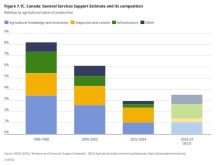“Sales increased because there was that consumer confidence. We’re hoping that same thing happens here in Canada.”
– ORGANIC SPECIALIST JOHN HOLLINGER, MAFRI , ON HOW REGULATION IN THE U. S. SPARKED MORE DEMAND FOR ORGANIC FOOD
Last year half of all Canadian and American households said they’d tried organic food.
They’re those driving a yearly 20 per cent increase in sales of organics and a proliferation of product on store shelves. It’s now estimated that three to five per cent of all products on store shelves today are organic.
Read Also

Canada seventh on agri-food influence
Comparison of 19 G20 countries says Canadian agri-food needs investments, processing, action on retail consolidation to realize potential
Those were figures rolled out during Manitoba Agriculture, Food and Rural Initiatives’ (MAFRI) Organic Week, which featured seminars held around the province to familiarize farmers with trends, organic farming techniques and regulation.
Domestic sales of organic foods are exceedingly strong in the U. S. and have been since 2000 with the arrival of its National Organic Program, the equivalent of Canada’s new organic product regulation set to take effect June 30, 2009, John Hollinger, the organic specialist with MAFRI, told one of the seminars.
A similar phenomena is expected around the corner in Canada. “Sales increased because there was that consumer confidence,” he said. “We’re hoping that same thing happens here in Canada.”
Right now demand for organic product is so high south of the border, product makers have actually pulled back and are selling less into Canada, said Brian Hunt, a MAFRI business development specialist. That’s an opening for “import replacement”
through more development of processed organic product here at home, he said.
People are motivated to switch to organic for a variety of reasons, Hunt said.
People perceive organic food to be nutritionally better and seek it out in their quest for personal health and wellness, he said.
Moreover, organic food offers the kind of traceability conventional food sources do not, and when it has the additional attribute of being locally grown, that’s emotionally reassuring for the consumer as well. That’s related to food safety concerns and the need to “put a face on your food,” he said.
In addition to where food comes from and how it’s grown, consumers also look for clean ingredient declarations on food they buy. These are listings of ingredients that the majority of people would know and recognize.
Over 2,000 new organic food products were introduced in 2006 – the most recent year of available data – and most of these were value-added products. More than a quarter of these products were private-label products or store-branded products such as President’s Choice Organics.
What’s happening in the market indicates a broader transition in purchasing patterns, as consumers develop a stronger social conscience around how they purchase and consume food, Hunt said.
What’s not clear now is what impact a faltering economy may have on these trends. If you’re losing your house you’re not likely interested in paying premium prices for organic food.
Other subjects covered at the seminars included organic crop rotation techniques, the Canadian Wheat Board’s organic contracts, certification dos and don’ts and prospects for producing and marketing organic beef.















